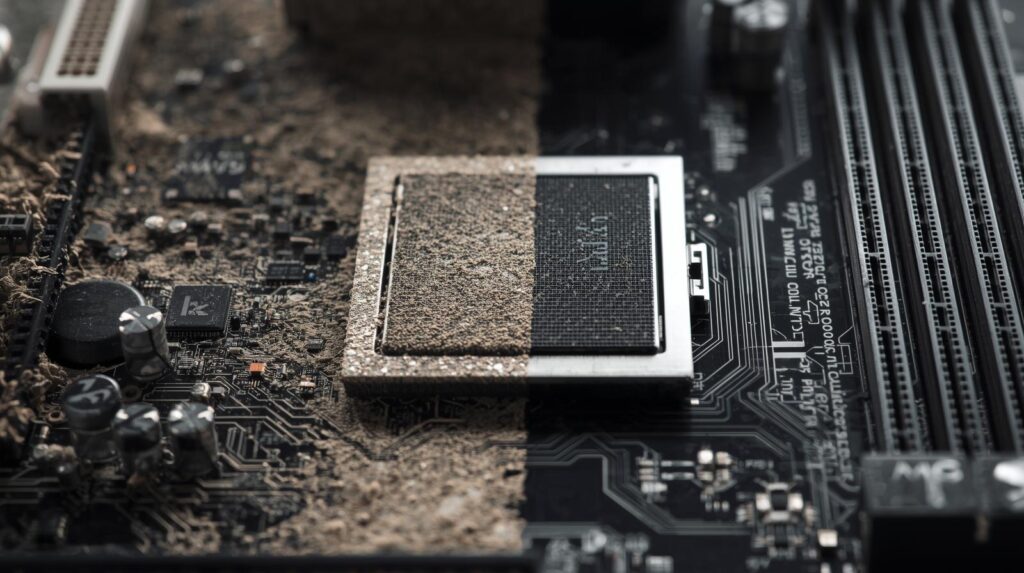Your computer’s motherboard is the heart of your system a delicate network of circuits, chips, and connectors that keep everything running smoothly. Yet, it’s also one of the most neglected components when it comes to maintenance. Over time, dust, grime, and residue can build up, leading to overheating, system instability, or even permanent damage.
According to a 2024 report by TechRadar Insights, nearly 37% of PC hardware failures are linked to poor maintenance or dust accumulation. Cleaning your motherboard isn’t just about aesthetics; it’s about preserving performance and extending your computer’s lifespan. In this guide, you’ll learn the safest, most effective, and expert-approved way to clean a motherboard like a pro.
Why Cleaning Your Motherboard Matters

Dust may seem harmless, but it acts like an insulator that traps heat. When your motherboard overheats, it can throttle performance and reduce the longevity of critical components like the CPU, GPU, and RAM.
Dr. Elaine Morris, a hardware engineer at PCWorld Labs, explains:
“A dusty or unmaintained motherboard can raise internal case temperatures by up to 15°C. That may not sound like much, but it’s enough to shorten component life and trigger system crashes under load.”
Regular cleaning not only improves airflow but also helps prevent electrical shorts caused by accumulated debris or moisture. A clean board ensures stable voltage flow and keeps your PC performing at its peak.
Essential Tools and Materials
Before you begin, it’s crucial to prepare the right tools. Using the wrong equipment can cause static discharge or physical damage to sensitive components.
What You Will Need
- Compressed air can or electric air blower
- 99% isopropyl alcohol (high-purity only)
- Anti-static brush or soft paintbrush
- Microfiber cloth or lint-free wipes
- Anti-static wrist strap (to prevent electrostatic damage)
- Clean, static-free workspace
A 2023 Linus Tech Tips hardware maintenance survey found that 83% of PC enthusiasts prefer isopropyl alcohol for motherboard cleaning due to its fast evaporation rate and non-conductive properties.
Preparation Before Cleaning

Before you touch your motherboard, safety comes first.
Power Down and Unplug
Turn off your computer and disconnect it from all power sources. Press the power button for a few seconds to discharge any residual energy.
Remove the Motherboard (If Possible)
While it’s possible to clean a motherboard inside the case, removing it allows better access and reduces the risk of static contact. Carefully unscrew and detach cables, noting where each connector goes.
Ground Yourself
Use an anti-static wrist strap or touch a grounded metal surface to prevent electrostatic discharge (ESD). Even a small static spark can destroy sensitive circuitry.
Step-by-Step Motherboard Cleaning Process
Cleaning should always be done with precision and patience. Follow these steps to ensure a thorough yet safe cleaning.
Step 1: Dry Dust Removal
Hold the compressed air can upright and spray short bursts from about 6–8 inches away. Move systematically across the board to remove surface dust.
If stubborn dust remains, use a soft anti-static brush to gently sweep between components and slots. Never use a vacuum cleaner it generates static electricity.
Step 2: Deep Cleaning with Isopropyl Alcohol
For sticky spots or corrosion, lightly dampen a microfiber cloth or cotton swab with 99% isopropyl alcohol.
Gently wipe the affected areas without over-saturating them. Alcohol evaporates quickly and leaves no residue, making it ideal for cleaning electrical parts.
Avoid applying liquid inside sockets or ports these should be cleaned only with air or a dry brush.
Step 3: Drying and Inspection
Once cleaned, let the motherboard air-dry completely for at least 30–60 minutes. Inspect for any remaining dirt, corrosion, or loose connectors.
According to Hardware Experts Network, improper drying is the cause of over 20% of post-cleaning motherboard failures, so never rush this stage.
Reinstallation and Testing
After ensuring the motherboard is fully dry, reinstall it into the case. Reconnect cables, plug in the power supply, and start your system. Observe fan speeds, temperature levels, and performance.
You can monitor your motherboard’s temperature using tools like HWMonitor or MSI Afterburner. A clean board often results in lower idle temperatures and quieter fan operation, indicating improved airflow and cooling efficiency.
Expert Maintenance Tips

- Clean your motherboard every 6 to 12 months, especially if you live in a dusty or humid environment.
- Keep your PC in a well-ventilated space with regular airflow.
- Use dust filters on your case fans to minimize debris accumulation.
- Avoid smoking or eating near your PC, as smoke residue and crumbs are difficult to remove.
- Store your computer in a low-humidity environment to prevent corrosion.
As TechClean Institute hardware technician Marcus Liu puts it:
“Regular motherboard maintenance isn’t just about cleanliness, it’s preventative care. A few minutes of cleaning can save you hundreds of dollars in repairs or replacements.”
Conclusion
Cleaning your motherboard may sound intimidating, but with the right tools and techniques, it’s a straightforward process that significantly boosts your system’s health and performance. From preventing overheating to extending hardware lifespan, routine maintenance ensures your PC runs reliably for years.
So, whether you’re a casual user or a gaming enthusiast, take the time to give your motherboard the care it deserves. Your computer will thank you with smoother performance, lower temperatures, and fewer unexpected crashes.
If you want to explore more guides and detailed comparisons on motherboards, check out our Complete Motherboard Guide | Types, Features, and Setup for PC Builders.

